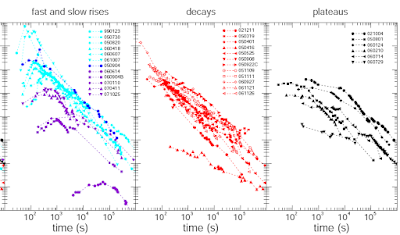主要内容:
包含了大量的数据!
统计主要是谱上的,还有L_p, E_p, spectral lag, redshift等
精彩摘抄:
 各个卫星所观测到的暴和余辉的个数
各个卫星所观测到的暴和余辉的个数
文章信息:
- · arXiv e-print (arXiv:0803.1821)
- · References in the Article
- ·
- · Translate This Page
| Title: |
| Global characteristics of GRBs observed with INTEGRAL and the inferred large population of low-luminosity GRBs |
| Authors: |
| Foley, S.; McGlynn, S.; Hanlon, L.; McBreen, S.; McBreen, B. |
| Publication: |
| eprint arXiv:0803.1821 |
| Publication Date: |
| 03/2008 |
| Origin: |
| ARXIV |
| Keywords: |
| Astrophysics |
| Comment: |
| 22 pages, 13 figures and appendix, accepted for publication in A&A |
| Bibliographic Code: |
| 2008arXiv0803.1821F |
Abstract
INTEGRAL has two sensitive gamma-ray instruments that have detected 46 gamma-ray bursts (GRBs) up to July 2007. We present the spectral, spatial, and temporal properties of the bursts in the INTEGRAL GRB catalogue using data from the imager, IBIS, and spectrometer, SPI. Spectral properties of the GRBs are determined using power-law, Band model and quasithermal model fits to the prompt emission. Spectral lags, i.e. the time delay in the arrival of low-energy gamma-rays with respect to high-energy gamma-rays, are measured for 31 of the GRBs. The photon index distribution of power-law fits to the prompt emission spectra is consistent with that obtained by Swift. The peak flux distribution shows that INTEGRAL detects proportionally more weak GRBs than Swift because of its higher sensitivity in a smaller field of view. The all-sky rate of GRBs above ~0.15 ph cm^-2 s^-1 is ~1400 yr^-1 in the fully coded field of view of IBIS. Two groups are identified in the spectral lag distribution, one with short lags <0.75>0.75 s. Most of the long-lag GRBs are inferred to have low redshifts because of their long spectral lags, their tendency to have low peak energies and their faint optical and X-ray afterglows. They are mainly observed in the direction of the supergalactic plane with a quadrupole moment of Q=-0.225+/-0.090 and hence reflect the local large-scale structure of the Universe. The rate of long-lag GRBs with inferred low luminosity is ~25% of Type Ib/c supernovae. Some of these bursts could be produced by the collapse of a massive star without a supernova or by a different progenitor, such as the merger of two white dwarfs or a white dwarf with a neutron star or black hole, possibly in the cluster environment without a host galaxy.
Bibtex entry for this abstract Preferred format for this abstract




.gif)



.gif)














